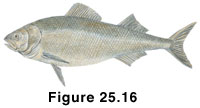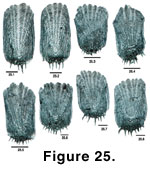 Description
DescriptionAnoplopoma fimbria
(Sablefish)
(Other common names: Blackcod, Coalfish, Coalcod)
Figure 25.16
 Description
DescriptionLength: up to 107 cm (Lamb and Edgell, 1986), but generally around 76 cm (Eschmeyer et al., 1983).
Mouth: moderate, terminal, directly slightly upwards; lower jaw does not extend past upper jaw; maxillary narrow and reach to below point below orbit; teeth fin and found in patches in jaws, vomer, and palatines.
Body: elongate and slightly compressed; conical head; two dorsal fins of equal size but well separated; greater than 15 spines in first dorsal fin; caudal fin forked.
Color: slatey black to green/gray on dorsal surface; light grey on ventral region; outer fin margins are pale; dorsal fin has black margin; operculum has black lining. Dorsolateral region may have small irregular dark stripes.
Depth: up to 1829 m.
Habitat: young and adults prefer muddy/silty bottoms with young in shallow and adults often in deeper waters.
Season: spawning occurs January to March along the continental shelf at depths greater than 1000 m. Larval sablefish are found in surface waters over the shelf and slope in April and May. Juveniles migrate inshore over the following six months and rear in nearshore and shelf habitats until age two to five when they migrate offshore and into the fishery.
Diet: forage fish (e.g., laternfish, saury), crustaceans, worms.
Predators: larger fish (e.g., halibut, lingcod), marine mammals.
Distribution: Baja, California to Alaska to the Bering Sea to the Sea of Japan.
 Scale
Description
Scale
DescriptionRelative Size of Scale: small to moderate; in the scale series, smallest to largest: A, C, E, G, I, J; reference material is from a 250 cm long individual).
Position of Scales on the Body: cover the body and head (Hart, 1973).
Overall Scale Shape: generally oval to slightly rectangular with slightly elongated lateral fields.
Focus and Circuli: the focus is not centralized between the fields and is approximately one-quarter to one-fifth of the way from the outside edge of the posterior field. The circuli are compact and continuous in the lateral fields only. Circuli are discontinuous in the anterior field. The posterior field is short, and the circuli do not appear to continue into it (may be partially masked by ctenii).
Radii: there are approximately four to six primary radii with a variable number of secondary radii. It is not determined whether this number is diagnostic. The radii are present in the anterior field only. The anterior field is convex and strongly scalloped.
Remarks: there is the potential to get sablefish scales confused with rockfish scales, however, there are some key differences. In sablefish the circuli in the anterior field are clearly discontinuous and the anterior edge is more strongly scalloped (almost fluted). If the ctenoid region is intact, rockfish seem to have a more heavily ctenoid posterior field with several small ctenii overlapping, giving an armoured appearance.
To date, there have been no sablefish found in Effingham Inlet cores. Because the scales are reasonably robust, they should have a good preservation potential, although the ctenoid region would likely disarticulate.